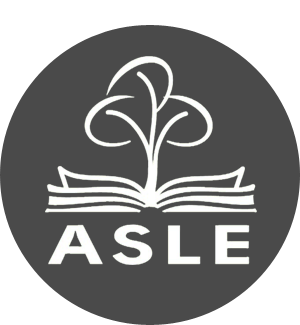 ASLE’s Scholar of the Month for January 2025 is Jeremy Chow.
ASLE’s Scholar of the Month for January 2025 is Jeremy Chow.
Jeremy Chow is an assistant professor of English at Bucknell University, which occupies the ancestral homelands of the Susquehannock peoples. Chow is the author of The Queerness of Water: Troubled Ecologies in the Eighteenth Century (2023) as well as three edited collections: Eighteenth-Century Environmental Humanities (2023), Unsettling Sexuality: Queer Horizons in the Eighteenth Century (2025) with Shelby Johnson, and The Edinburgh Companion to Queer Reading (2025) with Declan Kavanagh.
How did you become interested in studying ecocriticism and/or the environmental humanities?
In truth, it was kismet. I sought out a doctoral program with one research agenda in mind and that agenda was quickly revised after taking Teresa Shewry’s course, “Utopia & Ecology” during my first quarter. In retrospect, it seems impossible to not consider the wider stakes of the environmental humanities in a program housed on the eroding bluffs of the Pacific Ocean. In later semesters, as a literary scholar trained in the British eighteenth century, I found myself re-reading eighteenth-century texts with the lenses that Shewry’s course had offered. For instance, why was there all this environmental disaster in Daniel Defoe’s Robinson Crusoe? Why did the feculent smell of rancid waste in eighteenth-century London continue to capture poets of the period? Why were late eighteenth-century natural historians obsessed with rumors of violent animal appetites? These questions still keep me company in my scholarship, but the environmental humanities ultimately became an opportunity for me to explore a wider interdisciplinary field while honoring my commitments to queer and sexuality studies and theories of race and decolonization.
Who is your favorite environmental artist, writer, or filmmaker? Or what is your favorite environmental text? Why?
When meeting people and they find out you teach in an English department, there is almost always a knee-jerk question: What is your favorite book? After years of this, I have stopped rolling my eyes or laughing out loud (in retrospect, not ideal reactions for making new acquaintances). I smile, nod, and confess that such a question is impossible because I love so many for different reasons (typically these people have children and I clumsily making an analogy between favorite texts and favorite children; this is usually dissatisfactory because, I’ve come to find out through lived experience, people do, in fact, have favorite children). Here are some I love to teach. I habitually teach an upper-division seminar on animal studies, which is populated almost exclusively by non-humanities students. While housed in an English department the class represents a commitment to cultural studies and seeks to bridge the university’s various units: STEM, social sciences, Engineering, and arts and humanities. At the start of each semester, we begin by watching the heartbreaking documentary (clearly I’m a masochist because I rewatch it every time) Blackfish, which documents the treatment of orcas in captivity. Students are disturbed by the documentary, which asks them to consider issues of cognition, emotion, capitalism, and conservation (tenets of the course). At the same time, we read Thomas Nagel’s philosophical enquiry “What is it like to be a bat?” The essay demands we philosophically come to terms with the incommensurability of species and embodied experience in ways that can dispossess anthropocentric hubris. Of all the texts I teach in that seminar, students come back to these two time and time again. They are then my favorite because they inspire critical investigation and work to shift perspective, which I believe to be the hallmark of a robust collegiate education.
What are you currently working on?
I find myself constantly working on half a dozen projects at the same time. There’s something exciting to me about moving among several scholarly projects simultaneously that inspires, at least in my mind, cross-pollination. At the moment I’m at work on a handful of shorter essays and articles and two larger projects: an edited collection on waste and a second monograph on the relationship between animality and anticolonalism. Building on a co-authored open access essay, my collaborator and, more importantly, friend, Sage Gerson and I are in the process of editing a collection of essays on waste. In Summer 2024, Gerson and I hosted a summer institute through the Bucknell Humanities Center called “Waste Worlding.” The institute assembled a cohort of international scholars (4 of the 7 continents were represented) interested in key concepts within waste and discard studies. On the heels of that institute, we are now working with our collaborators to produce a keywords project that explores critical concepts in the field and which could motivate undergraduate and graduate teaching. At the same time, I’m working on my second book project, tentatively titled Animal Empires: Interspecies Violence in the Global Eighteenth Century, which builds off a series of interspecies fringe moments I discussed in my first book. Animal Empires returns to eighteenth-century art, natural history, and literature to magnify strange and uncomfortable moments of animalized violence that shocks and waylays (perhaps only momentarily) imperial interlopers. Consider, for instance, the musical automata Tipu’s Tiger, which is housed at the Victoria and Albert Museum, and commemorates the mauling death of English solider Hugh Munro by a Bengal tiger in the 1790s. Alongside these textual examples, I return to the invocation of the animal in anticolonial and decolonial treatises, for example by Frantz Fanon, Achille Mbeme, and Aimé Césaire to press the rhetoric, metaphor, and materiality of the animal as a rallying call for decolonization.
What is something you are reading right now (environmental humanities-related or otherwise) that inspires you, either personally or professionally?
As we know, pleasure reading during a teaching term is limited. But at the start of the term I finished two books that were gifted to me and which have stayed with me throughout my semester: K Ming Chang’s Bestiary and Torrey Peters’s Detransition, Baby. I often find that our most inspirational reads are those shared with us by colleagues, friends, and loved ones; this was certainly the case for Bestiary and Detransition, Baby. And I’d also like to think that the books that inspire us most are those we are eager to share with others so as to find an interlocutor with whom one can confer and dissipate the intrinsic loneliness that accompanies solitary reading. What excites me about Chang’s work is its beautifully composed magical realism and its illustration of Asian (American) identity, animality, and queer attachments. It’s multigenerational narrative is also stylistically experimental, which is something that I find myself returning to because there are aspects of it that disorient me. And while disorientation may keep some readers at bay, in Chang’s novel I find it an invitation for re-reading, which is something that the best of books demand. Around the same time, a friend loaned me Detransition, Baby, which I had encountered, at least titularly, in a variety of queer and trans community conversations. But I found myself engrossed, despite the small font size. The ambiguous ending that harkens back to, at least for me, Kate Chopin’s The Awakening and its aqueous conclusions, spurred conversations with colleagues and students alike.
Is there a scholar in the field who inspires you? Why?
I would not have found my way into the work that excites me without the inspiration and collegiality of senior colleagues. During graduate school I happened to meet both Nicole Seymour (CSU Fullerton) and Neel Ahuja (University of Maryland) whose work in the environmental humanities and queer, trans, and sexuality studies is a constant reminder of what can be accomplished through creativity, brilliance, and intersectionality. What stands out to me about Seymour’s work is the whimsy and humor that she brings to the field; her wit is comforting, especially to students, who may be unfamiliar with the environmental humanities. Ahuja’s navigation of critical ethnic studies and histories of (and the ongoingness of) colonialism inspire me as a scholar whose work traverses several historical periods. Perhaps most inspirational, however, is the service that both have done to the field to welcome and motivate historically marginalized and minoritized junior and emerging scholars. This is, in my experience, exceeding rare in the academy. What I have found Seymour and Ahuja model is both an exceptional mode of critical inquiry and exceptional mode of collegiality. I aspire to model myself after them.
